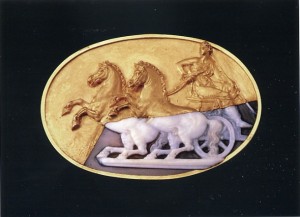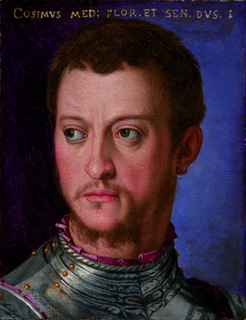A “Gem” of a show at the Bowers Museum
Did you know that this is the official “Year of Italian Culture in the United States”? With this week’s closing of Piranesi, Rome and the Arts of Design at the San Diego Museum of Art, another important world premier exhibition of Italian culture is nearby.

A Hellenistic gem fragment with gold integration attributed to Benvenuto Cellini from “Gems of the Medici” at the Bowers Museum.
“Chariot with Male Figure.” Sardonyx and gold; 45 x 65 mm.
Collection: Museo Archeological Nazionale, Florence.
Image: © 2013 by Ministero per i Beni e le Attività Culturali, Rome.
An exhibition of gems, medallions, and gold amassed by the Medici—Renaissance Italy’s most famous and powerful family—is now on view at the Bowers Museum close by in Santa Ana. The exhibition, Gems of the Medici, features ancient carved cameos from the Hellenistic and Roman eras as well as spectacular gems made during the Renaissance and later.
The Medici family of Florence gained extraordinary power and wealth through banking. As “usury” was considered a sin by the church, the Medici bank expanded throughout Europe becoming that continent’s first central bank. They made their extreme fortune by issuing “Bills of Exchange” where a person could deposit money at a Medici bank in one city and then not risk traveling with their money on their person, which might be stolen. With outposts in Bruges, Milan, Rome, and even England, upon arriving at their destination the travelers could pick up their money—converted into the new city’s currency. It was the differing currency exchange rates and the fees charged to do so that actually began the Medici financial empire.

Cameo carved by the famous Hellenistic engraver Protarchos with later added gold mount from “Gems of the Medici” at the Bowers Museum.
“Eros Riding a Lion,” 1st-century BCE.
Onyx and gold; 20 x 26 mm.
Collection: Museo Archeologico Nazionale, Florence.
Image: © 2013 by Ministero per i Beni e le Attività Culturali, Rome.
With such fortune amassed, the Medici family became both interested in Platonic Humanism and patrons of the arts. They commissioned humanist paintings such as The Birth of Venus by famous artist Botticelli and sponsored upcoming artists such as Michelangelo Buonarroti. The family became interested in all things from classical Greece and Rome and collected antiquities including small gems featuring cameos depicting classical mythology.
One such exquisite cameo collected by the scion of the family, Cosimo De’ Medici, is Icarus and Daedalus, Pasiphaë and Artemis. Carved from niccolite, the delicate gem depicts the famous architect father, who built the mythological Labyrinth prison of the Minotaur on the island of Crete, and his son who together made wings of wax and feathers to try fly away from their nemesis, King Minos. Upon the duo’s flight away from the island, Icarus flew too close to the sun thus melting the wax holding the feathers to the wings upon which he was flying and plummeted to his death in the sea. The cameo, itself, features a beautiful nude Icarus, standing posed in classically balanced “contrapposto,” wearing the ill-fated wings. Next to him is his aged father. Flanking the father and son on the left is Pasiphaë who was the daughter of the ancient sun god Helios and mother of the labyrinth’s Minotaur. On the right side is Artemis the goddess who represents transitions and was also the sister to sun god Apollo. The presence of the two goddesses refer to the before and after of Icarus’s failed flight.
Another delicate, treasured cameo from the Hellenistic era, and one of Lorenzo de’ Medici’s (also known as “Lorenzo the Magnificent”) favorites, is a tiny Bust of Minerva from the Hellenistic first century BCE. She is similar to the goddess Athena and was the goddess of wisdom, just warfare, and the arts. Wearing her Greek helmet of war the goddess with her perfect aquiline profile is carved in pale white onyx. As one of Lorenzo’s prized gems he even had his initials “LAV-R-Med” inscribed onto the top of the tiny helmet.
As the small Bust of Minerva is from the Hellenistic-Greek culture, it actually does depict the Greek goddess Athena and not the similar Roman goddess Minerva. This is continually problematic in exhibition’s didactic information and throughout the exhibition catalogue. Greek and Roman names of gods and goddesses are continually confused. Roman names are arbitrarily applied to Greek-Hellenistic gods and goddesses throughout the exhibition.

Florentine Manufactured “Vase with Cover.” Lapis lazuli, gold, and enamels.
Collection: Museo degli Argenti, Florence.
Image: © 2013 by Ministero per i Beni e le Attività Culturali, Rome.
Another cameo in the collection is from the late Roman period. Emperor Sacrificing to Hope is a very large 5 ½-inch carved white and brown onyx cameo mounted in gold featuring a Roman emperor giving an offering to the Roman goddess Hope. As a late period Roman work, it exemplifies the introduction of the more vulgate clumsy style that begins to appear in late Roman artworks of this time-period. It is not a beautiful relic, but it is stylistically important because it is large, gaudy, and ugly—everything one would expect from the decline of the Roman Empire. Additionally, the gem is remarkable because it is very rare that something so large has survived for so long in such perfect condition.
One display case of the exhibit contains the main asset of the Medici: littering the bottom of this case are scores of “fiorino d’oro” (gold florins). Each dime-size gold coin weighs 3.5 grams and features on the obverse (“heads”) a fleur de lis, which is the emblem of Florence. On the reverse is Saint John the Baptist who was the patron saint of Florence.

Bronzino’s “Portrait of Cosimo I de’ Medici,” ca. 1555–1565.
Oil on tin; 16 x 12 cm.
Collection: Galleria degli Uffizi, Florence.
Image: © 2013 by Ministero per i Beni e le Attività Culturali, Rome.
Other than gems, a few sculptures and paintings accompany the exhibition. A real treat to see is a portrait painted by Agnolo di Cosimo, better known as Bronzino. The small Portrait of Cosimo I de’ Medici from ca. 1555–1565, features Bronzino’s typical, elegant elongation of form and also remarkably depicts the light shining off the armored collar of the sitter. This late 16th-century style, known as Mannerism, with its elongation of form is a late innovation of the Renaissance, where artists would elegantly distort their figures to look more stylistically elegant rather than create figures with absolutely faithful accuracy, which was appreciated earlier in the century.
A very peculiar object is also part of the exhibit. It is an image of the historical Dominican friar Girolamo Savonarola who was a heretic priest that espoused morality, anti-corruption, and despised both the corruption of the Medici and the Pope. He was such an irritant that he was excommunicated and eventually put to death by hanging in 1498. The object is an intaglio (a negative, below-the-surface carving method) cut stone created by Giovani di Lorenzo di Pietro delle Opere. Savonarola’s portrait is carved into a large piece of the red mineral carnelian and was purchased by Cosimo I de’ Medici. The friar is depicted in his cowl and the gem’s likeness was very much admired by the famed biographer Gorgio Vasari, where the gem is mentioned in the author’s famed book, Lives of the Artists. Viewing the object is both eerie and grand as the image of the heretic priest glows within the red crystalline stone like a hologram. This is a highlight of the entire exhibition.
Other remarkable objects can be found in the exhibition, such as the actual pietra dura (inlaid mosaic of hardstones) encrusted top door of the cabinet that housed the collection of gems in the Medici palace, a solid football-sized lapis lazuli urn, as well as many other lavish objects.
This exhibition may not be for everyone, although there are many exquisite objects in this exhibit and each is rich with historical minutiae. However, people who are earnestly interested in art history and people who love all things from both classical antiquity and the Italian Renaissance will adore this jewel of an exhibition.
Gems of the Medici at the Bowers Museum runs from April 16 to September 15, 2013.
© 2013 by Kraig Cavanaugh

Kraig Cavanaugh lectures about art history—specializing in Modern & Contemporary Art—as well as being an instructor of color theory, design, and studio art. He has curated numerous art exhibitions, authored exhibition catalogues, and written art reviews for several other print and online journals including “Artweek” (USA) and “Selvedge” (UK) magazines. Cavanaugh is also an invited member of the Association Internationale des Critiques d’Art (United States division), which is an NGO in official relations with UNESCO.

Good article .Informative and pertinent. Makes one want to see the exhibit.